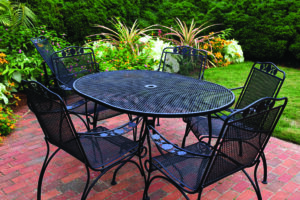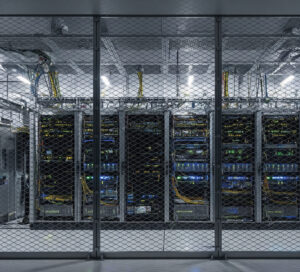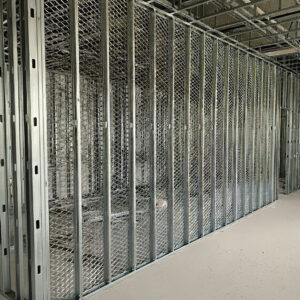Architectural Expanded Metals
by hanna_kowal | November 10, 2025 8:36 am
 [1]
[1]Image generated by AI using Gemini
Architects and designers aim to shape environments that enhance the quality of life, and material selection is central to this mission. Expanded metal, also known as architectural mesh, stands out for its unique ability to serve multiple purposes within a project. Manufactured by slitting and stretching metal to give it its industrial and uniform, diamond-shaped pattern—and available in a variety of decorative designs—it is lightweight, strong, and commonly used for facades and cladding. These applications offer a blend of aesthetic appeal, solar shading, and natural ventilation. With its flexibility and adaptability, expanded metal enables architects to extend possibilities beyond the building envelope, creating a cohesive design throughout a project.
Perimeter fencing for security and style
For architects and designers, fencing is not just a boundary; it is an essential component of a project’s aesthetics, security, and overall integrity. Expanded metal fencing provides a solution that balances these demands with high performance and versatility. Its unique single-piece construction eliminates the weak points often found in traditional fencing, making it exceptionally resistant to cutting, unraveling, and tampering. This provides an added layer of security for both residential and high-security commercial applications. Small, rigid openings restrict visibility and prevent climbing by eliminating hand and footholds.
Importantly, strength and security do not come at the expense of design flexibility. Expanded metal maintains its durability if the project calls for a classic diamond pattern or a decorative mesh. Architects can select patterns matching their vision, from stark, minimalist designs to intricate, textured appearances. Panels can be finished with a durable powder coating in any color, providing both corrosion resistance and an opportunity to integrate the fencing into the project’s color palette. For a natural partition, climbing plants can be introduced to grow throughout each panel’s open structure, creating living green walls that blend security with organic beauty.
Doors, windows, and screening solutions
Architectural meshes are typically characterized by large openings; however, their versatility extends to use with small ones. Excellent for door and window screens, they provide a highly durable and secure alternative to a traditional screen. While it is a sturdier option, it still allows light and air to flow, ideal for locations requiring ventilation and a strong physical barrier against pets, insects, and intruders. Manufactured from a single metal sheet, it resists damage from animals, impacts, and long-term wear and tear much better than a traditional screen. The open mesh design allows for air and light to pass, and some have openings that are small enough to keep out insects like gnats while still allowing for outward views and ventilation. Its integral strength serves as a permanent deterrent against forced entry, especially for ground-floor windows, doors, or any application where security is a priority.
For pet owners, a cost-friendly solution to protect the screen door from rips and scratches is to add a pet grille to the bottom. This eliminates the need to replace the entire screen door. They are readily available in typical sizes to fit common door widths and even sliding screen doors. They are relatively easy to install, available in different finishes, and feature diamond and decorative expanded metal patterns.
Aluminum expanded metal is highly resistant to rust and other weather damage, making it suitable for interior and exterior use. Adding powder coat further extends the screen or pet grille’s lifecycle and can complement existing architectural designs. Engineered to last for decades, they reduce the need for frequent replacements or repairs, which can lower long-term costs.
Furniture and public spaces
 [2]
[2]Photo courtesy Imagesbybarbara/iStockphoto.com
Architects can also leverage expanded metal’s design flexibility and high strength-to-weight properties for furniture. Its resistance to heavy loads, extensive use, and harsh weather ensures a long lifespan for both indoor and outdoor uses. The flattened, open mesh also allows for quick drainage of rain and melting snow to inhibit rust and wear. This is important for use as park and sport benches, picnic tables, and trash cans used in outdoor public spaces or other high-traffic areas. Thicker strands with large openings of 25.4 mm (1 in.) to 50.8 mm (2 in.) and a protective UV polyurethane coating are recommended. This coating adds color that resists fading, enhances durability, and helps keep the metal cooler to the touch in the sun.
For restaurants and cafes, flattened mesh with small openings of 19 mm (0.75 in.) is recommended for tables and chairs. It is more comfortable while dining, provides back support, and utensils will not fall through the tabletop while providing a smooth dining surface. All expanded metal furniture can use decorative mesh and be painted or powder-coated to match any decor.
Safety, walkways, and industrial applications
 [3]
[3]For areas where safety is paramount, expanded metal grating is strong and durable with a slip-resistant surface, ideal for use as safety corridors, rooftop walkways, scaffolding, industrial catwalks, and stairs. The raised openings provide excellent traction to prevent slips, which are vital in hazardous environments like oil refineries, offshore platforms, or other areas prone to adverse weather or slippery surfaces. Oils, ice, water, and other debris easily fall through the mesh, allowing the surface to dry quickly. Vertical panels can be erected on both sides of the walkway to establish a dedicated safety corridor and prevent falls for technicians servicing elevated or rooftop equipment. Made from materials like carbon steel, stainless steel, or aluminum and often finished with galvanization or powder coating for corrosion resistance, expanded metal walkways offer a long, low-maintenance service life. Color can also be added to identify a hazardous area. In factories, yellow or red mesh can be used as a highly visible warning for dangerous equipment. Elevated gangways of theaters or arenas can be painted black to match the ceiling, concealing the mechanical infrastructure and rigging.
High-security environments
 [4]
[4]In high-security design, visibility must be balanced with effective protection. Expanded metal offers a solution that excels in both areas, making it ideal for creating secure zones within a larger structure. Its rigid, single-piece construction makes it exceptionally resistant to tampering or access, ideal for applications like supply or inventory lockers, IT server rooms, hazardous areas, or even detention centers. The material’s open mesh allows for non-intrusive surveillance or inspection, providing clear sightlines for monitoring equipment, inventory, or occupants. Expanded metal panels can be configured in multiple ways: bolted to existing walls for a secure boundary, installed from floor to ceiling, or assembled into a fully enclosed cage. For an even higher level of protection, flattened sheets can be attached to wall and ceiling studs, or embedded within concrete layers to create a formidable barrier against forced entry in high-target environments like banks or jewelry stores.
Retail and brand identity
 [5]
[5]and footholds.
Photo courtesy beekeepx/Shutterstock.com
In retail design, the choice of material is not merely functional—it is a critical driver of spatial experience and brand. Expanded metal offers architects a versatile and dynamic material for creating compelling retail environments. Its unique, open-mesh structure provides a balance of transparency and sturdiness. This allows for innovative design solutions that control light and visibility, such as semi-transparent partitions, screen walls, or shelving that can define spaces without fully blocking sightlines or ventilation. In retail, this is especially useful for creating a sense of openness and flow, allowing customers to see merchandise from a distance while still delineating distinct zones like checkout areas, product displays, or fitting rooms.
Beyond its functional properties, expanded metal is a powerful visual tool that can contribute to a store’s unique brand identity. When used for ceiling panels or feature walls, it can conceal unsightly ductwork and wiring while creating depth and shadow effects that enhance the spatial experience. As custom retail fixtures, shelving, clothing racks, and display stands, it provides a durable and lightweight solution that can be easily configured. Architects can further enhance their visual impact by incorporating corporate branding, backlighting, or strategic illumination to highlight pattern uniformity while creating a modern, industrial aesthetic that can be tailored to a brand’s identity through various finishes and colors to capture attention and elevate the shopping experience.
Flexibility, performance, and sustainability
Ultimately, expanded metal offers a rare combination of design flexibility, robust performance, and environmental responsibility. Its waste-free manufacturing process maximizes material usage, and its ability to contribute to LEED certification makes it an ideal choice for architects committed to sustainable design. This combination of form, function, and green building principles establishes expanded metal as a valuable tool that is more than just a facade solution. It enables architects to push design boundaries—from fencing and furniture to retail, safety, and high-security environments with virtually limitless applications—expanded metal delivers form, function, and environmental responsibility in a single, versatile material.
Manuel E. Menchaca, MBA, is the senior marketing manager for Wallner Expac, which manufactures custom-designed expanded metal for architectural and construction applications, and is one of the world’s largest producers of expanded metals for HVAC filters. For more information, visit www.expac.com.
- [Image]: https://www.metalarchitecture.com/wp-content/uploads/2025/11/2025-Oct-Nov-Beyond-Facades-Pictures-Screen-Door.jpg
- [Image]: https://www.metalarchitecture.com/wp-content/uploads/2025/11/2025-Oct-Nov-Beyond-Facades-Pictures-Table-and-Chairs.jpg
- [Image]: https://www.metalarchitecture.com/wp-content/uploads/2025/11/2025-10-MAN-Expanded-Metal-Beyond-Facades-Article-Collage.jpg
- [Image]: https://www.metalarchitecture.com/wp-content/uploads/2025/11/2025-Oct-Nov-Beyond-Facades-Pictures-IT-Protection.jpg
- [Image]: https://www.metalarchitecture.com/wp-content/uploads/2025/11/2025-Oct-Nov-Beyond-Facades-Pictures-Security-Cage1.jpg
Source URL: https://www.metalarchitecture.com/articles/architectural-expanded-metals/